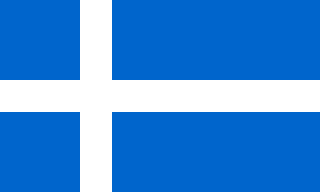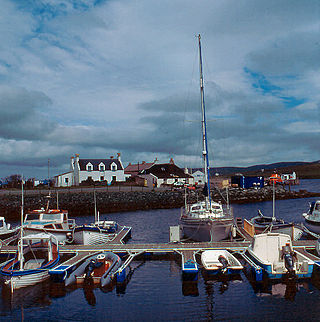
Weisdale Mill is a watermill in the village of Weisdale, Shetland, Scotland. It is located near the head of Weisdale Voe on the west of the island, a twenty-minute drive from the main town of Lerwick. [1]

Weisdale Mill is a watermill in the village of Weisdale, Shetland, Scotland. It is located near the head of Weisdale Voe on the west of the island, a twenty-minute drive from the main town of Lerwick. [1]
Weisdale Mill was built in 1855 and was Shetland's largest corn mill. [2] It is marked on c.1900 Ordnance Survey maps as Mill of Kergord. [3]
The Weisdale Mill was a busy working mill for many years until the early 1930s. Crofters and farmers came from some considerable distance to get their oats and corn ground into meal and flour. With very little in the way of transport people walked long distances with their crops which then had to be left at the mill and collected at a later date. Some crofters came up the Weidale Voe by boat as far as they could and then walked the short distance to the mill.
In 1936 it was bought by a local farmer (Tony Anderson) and was converted into a slaughter house and butcher shop. The slaughter house was in the basement (where the cafe is now). The ground floor was used for the butcher shop. The top floor was used for storage and was often used to salt sheepskins before they were sold. The butcher shop and slaughter house were very busy particularly during the war years when large numbers of men from the forces were stationed at Scatsta. Anderson also ran a large walk-in butcher van which visited many areas of Shetland daily selling beef and lamb.
During the war the mill was reputedly hit by enemy fire and some bullets came in the back door which was open at the time. No one was hurt.
In 1982 the building ceased to function as a butcher shop and slaughter house. It stood empty for some time but after extensive renovations, completed in 1994, the site is now managed by Shetland Arts and contains the Bonhoga Gallery, [4] (an art gallery whose name means "my spiritual home" [5] ) the Mill Cafe and a gift shop.

Shetland, also called the Shetland Islands, is an archipelago in Scotland lying between Orkney, the Faroe Islands, and Norway. It is the northernmost region of the United Kingdom.

Foula, located in the Shetland archipelago of Scotland, is one of the United Kingdom's most remote permanently inhabited islands. Owned since the turn of the 20th century by the Holbourn family, the island was the location for the film The Edge of the World (1937). The liner RMS Oceanic was wrecked on the nearby Shaalds of Foula in 1914. The island has a post office.
Yell is one of the North Isles of Shetland, Scotland. In the 2011 census it had a usually resident population of 966. It is the second largest island in Shetland after the Mainland with an area of 82 square miles (212 km2), and is the third most populous in the archipelago, after the Mainland and Whalsay.
Papa Stour is one of the Shetland Islands in Scotland, with a population of under fifteen people, some of whom immigrated after an appeal for residents in the 1970s. Located to the west of mainland Shetland and with an area of 828 hectares, Papa Stour is the eighth largest island in Shetland. Erosion of the soft volcanic rocks by the sea has created an extraordinary variety of caves, stacks, arches, blowholes, and cliffs. The island and its surrounding seas harbour diverse populations of wildlife. The west side of the island is a Site of Special Scientific Interest and the seas around the island are a Special Area of Conservation.

East Burra is one of the Scalloway Islands, a subgroup of the Shetland Islands in Scotland. It is connected by a bridge to West Burra.

Shapinsay is one of the Orkney Islands off the north coast of mainland Scotland. With an area of 29.5 square kilometres (11.4 sq mi), it is the eighth largest island in the Orkney archipelago. It is low-lying and, with a bedrock formed from Old Red Sandstone overlain by boulder clay, fertile. Consequently, most of the area is given over to farming. Shapinsay has two nature reserves and is notable for its bird life. Balfour Castle, built in the Scottish Baronial style, is one of the island's most prominent features, a reminder of the Balfour family's domination of Shapinsay during the 18th and 19th centuries; the Balfours transformed life on the island by introducing new agricultural techniques. Other landmarks include a standing stone, an Iron Age broch, a souterrain and a salt-water shower.

The Northern Isles are a chain of islands off the north coast of mainland Scotland. The climate is cool and temperate and highly influenced by the surrounding seas. There are two main island groups: Shetland and Orkney. There are a total of 36 inhabited islands, with the fertile agricultural islands of Orkney contrasting with the more rugged Shetland islands to the north, where the economy is more dependent on fishing and the oil wealth of the surrounding seas. Both archipelagos have a developing renewable energy industry. They share a common Pictish and Norse history, and were part of the Kingdom of Norway before being absorbed into the Kingdom of Scotland in the 15th century. The islands played a significant naval role during the world wars of the 20th century.
Vaila is an island in Shetland, Scotland, lying south of the Westland peninsula of the Shetland Mainland. It has an area of 327 hectares, and is 95 metres (312 ft) at its highest point.

South Havra, formerly Hevera, is an uninhabited island in the Scalloway Islands, Shetland, Scotland.

The Shetland Bus was the nickname of a clandestine special operations group that made a permanent link between Mainland Shetland in Scotland and German-occupied Norway from 1941 until the surrender of Nazi Germany on 8 May 1945. From mid-1942, the group's official name was the Norwegian Naval Independent Unit (NNIU). In October 1943, it became an official part of the Royal Norwegian Navy and was renamed the Royal Norwegian Naval Special Unit (RNNSU). The unit was operated initially by a large number of small fishing boats and later augmented by three fast and well-armed submarine chasers – Vigra, Hessa and Hitra.

Aith,, is a village on the Northern coast of the West Shetland Mainland, Scotland at the southern end of Aith Voe, some 21 miles west of Lerwick.
The MV Braer was an oil tanker which ran aground during a storm off Shetland, Scotland, in January 1993, and nearly a week later broke up during the most intense extratropical cyclone on record for the northern Atlantic Ocean, the Braer Storm of January 1993.

Dalgarven Mill is near Kilwinning, in the Garnock Valley, North Ayrshire, Scotland and it is home to the Museum of Ayrshire Country Life and Costume. The watermill has been completely restored over a number of years and is run by the independent Dalgarven Mill Trust.

Yell Sound is the strait running between Yell and Mainland, Shetland, Scotland. It is the boundary between the Mainland and the North Isles and it contains many small islands. Sullom Voe, on the shores of which is a substantial oil terminal, is an arm of Yell Sound.

Weisdale is a bay, hamlet and ancient parish on Mainland in Shetland, Scotland. The bay opens near the northern extremity of Scalloway Bay, and strikes four and a half miles to the north north east.
Shetland Arts Development Agency or Shetland Arts for short, is a Scottish charity formed in 2006 with a remit to "encourage and assist in promoting and advancing the creation, practice and presentation and study of all forms of art - visual, performing and creative."
The History of Shetland concerns the subarctic archipelago of Shetland in Scotland. The early history of the islands is dominated by the influence of the Vikings. From the 14th century, it was incorporated into the Kingdom of Scotland, and later into the United Kingdom.

Church Street is a pedestrianised street in the centre of Monmouth, Wales. It contains a variety of independent shops, restaurants, commercial art galleries, and the Savoy Theatre. Until the 1830s, when Priory Street was built to bypass it, it was the main thoroughfare into the centre of Monmouth from the north-east, linking the market and the parish church. It was at one time the centre of the town's butchery trade and was known as Butcher's Row.

Ronas Voe is a voe in Northmavine, Shetland. It divides the land between Ronas Hill, Shetland's tallest mountain, and the Tingon peninsula. It is the second largest voe in Shetland, the largest being Sullom Voe. The townships of Heylor, Voe and Swinister are located on its shores, and the township of Assater is under a kilometre away.